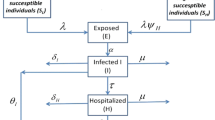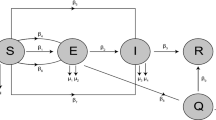Abstract
In this paper, we establish an Ebola epidemic model incorporating limited medical resources and immunity loss, and also consider the tracking and quarantining of susceptible individuals. Meanwhile the stability of the disease-free equilibrium is proved. Furthermore, we deduce the existence of multiple endemic equilibria and the occurrence of bifurcation. And then, using the partial ranking correlation coefficient (PRCC), it is found that the control reproduction number is most correlated with the parameter \(\rho \) (incineration or burial rate of dead bodies). Additionally, based on the data of the Ebola epidemic in Uganda in 2022, the fitted curve of accumulated infectious cases stabilizes at 143, which is eventually consistent with the actual data. Finally, numerical simulation results indicate that the peak value of infectious individuals decreases by 52.3% when the maximum treatment recovery rate changes from 20% to 40%. And while the hospital bed-population ratio increases by 10%, the peak value of the infectious decreases by 29.1%. Simultaneously, when the rate of immune loss decreasing from 60% to 20%, the peak value of the infectious decreases by 13.2%. While enhancing the tracking and quarantining of susceptible individuals have significant impact on the prevention and control of Ebola.







Similar content being viewed by others
References
World Health Organization: Ebola virus disease. https://www.who.int/news-room/fact-sheets/detail/ebola-virus-disease. Accessed 15 May 2023
Legrand, J., Grais, R.F., Boelle, P.Y., et al.: Understanding the dynamics of Ebola epidemics. Epidemiol. Infect. 135, 610–621 (2007)
Feng, Z.L., Zheng, Y.Q., Hernandez-Ceronb, N., et al.: Mathematical models of Ebola-consequences of underlying assumptions. Math. Biosci. 277, 89–107 (2016)
Wang, X., Shi, Y., Feng, Z., et al.: Evaluations of interventions using mathematical models with exponential and non-exponential distributions for disease stages: the case of Ebola. Bull. Math. Biol. 79, 2149–2173 (2017)
Tadmon, C., Kengne, J.N.: Mathematical analysis of a model of Ebola disease with control measures. Int. J. Biomath. 15, 1–39 (2022)
Ouemba Tasse, A.J., Tsanou, B., Lubuma, J., et al.: Ebola virus disease dynamics with some preventive measures: a case study of the 2018–2020 KIVU outbreak. J. Biol. Syst. 30, 113–148 (2022)
Njankou, S.D., Nyabadza, F.: Modelling the role of human behaviour in Ebola virus disease (EVD) transmission dynamics. Comput. Math. Methods Med. 4150043, 1–11 (2022)
Agbomola, J.O., Loyinmi, A.C.: Modelling the impact of some control strategies on the transmission dynamics of Ebola virus in human-bat population: an optimal control analysis. Heliyon 8, e12121 (2022)
Seck, R., Ngom, D., Ivorra, B., et al.: An optimal control model to design strategies for reducing the spread of the Ebola virus disease. Math. Biosci. Eng. 19, 1746–1774 (2022)
World Health Organization: DR Congo declares end to latest Ebola outbreak. https://news.un.org/en/story/2022/07/1121922. Assesed 27 Apr 2023
World Health Organization: Uganda declares end of Ebola virus outbreak. https://news.un.org/en/story/2023/01/1132352. Assessed 27 Apr 2023
Zhao, J., Wang, L., Han, Z.: Stability analysis of two new SIRS models with two viruses. Int. J. Comput. Math. 95, 2026–2035 (2018)
Liu, Z., Tian, C.: A weighted networked SIRS epidemic model. J. Differ. Equ. 269, 10995–11019 (2020)
Xiang, L., Zhang, Y., Huang, J.: Stability analysis of a discrete SIRS epidemic model with vaccination. J. Differ. Equ. Appl. 26, 309–327 (2020)
Selvan, T.T., Kumar, M.: Dynamics of a deterministic and a stochastic epidemic model combined with two distinct transmission mechanisms and saturated incidence rate. Phys. A 619, 128741 (2023)
Liu, C., Cui, R.: Analysis on a diffusive SIRS epidemic model with logistic source and saturated incidence rate. Discrete Contin. Dyn. Syst. Ser. B. 28, 2960–2980 (2023)
Wang, W.: Backward bifurcation of an epidemic model with treatment. Math. Biosci. 201, 58–71 (2006)
Shan, C., Zhu, H.: Bifurcations and complex dynamics of an SIR model with the impact of the number of hospital beds. J. Differ. Equ. 257, 1662–1688 (2014)
Shan, C., Yi, Y., Zhu, H.: Nilpotent singularities and dynamics in an SIR type of compartmental model with hospital resources. J. Differ. Equ. 260, 4399–4365 (2016)
Zhao, H., Wang, L., Oliva, S.M., et al.: Modeling and dynamics analysis of Zika transmission with limited medical resources. Bull. Math. Biol. 82, 99 (2020)
Fan, G., Li, J., Belair, J., et al.: Delayed model for the transmission and control of COVID-19 with Fangcang shelter hospitals. SIAM J. Appl. Math. 83, 276–301 (2023)
Boaden, R., Proudlove, N., Wilson, M.: An exploratory study of bed management. J. Manage. 13, 234–250 (1999)
World Health Organization, World Health Statistics 2005–2011
Berge, T., Lubuma, J., Ouemba Tase, A.J., et al.: Dynamics of Host-reservoir transmission of Ebola with spillover potential to humans. Electron. J. Qual. Theory 4, 1–32 (2018)
World Health Organization, WHO interventions to support the Ebola response in Uganda—September 2022-08 February 2023
Djiomba, S.D., Nyabadza, F.: Modelling the potential role of media campaigns in Ebola transmission dynamics. J. Differ. Equ. 2017, 1–13 (2017)
World Health Organization: The global observatory: Explore a world of health data. https://www.who.int/countries/uga/. Assessed 27 April 2023
Ma, Z., Zhou, Y., Li, C.: Qualitative and Stability Methods of Ordinary Differential Equations (in Chinese), 2nd edn. Science Press, Beijing (2015)
Sheng, Y., Jing, J., Guo, S.: The modeling and analysis of the COVID-19 pandemic with vaccination and isolation: a case study of Italy. Math. Biosci. Eng. 20, 5966–5992 (2023)
Dreessche, P., Watmough, J.: Reproduction numbers and sub-threshold endemic equilibria for compartmental models of disease transmission. Math. Biosci. 180, 29–48 (2002)
Guo, S.B., Ma, W.B., Zhao, X.Q.: Global dynamics of a time-delayed microorganism flocculation model with saturated functional responses. J. Dyn. Differ. Equ. 30, 1247–1271 (2018)
Bai, Y.Z., Wang, X.J., Guo, S.B.: Global stability of a mumps transmission model with quarantine measure. Acta Math. Appl. Sin.-E 37, 665–672 (2021)
Guo, S.B., Ma, W.B.: Remarks on a variant of Lyapunov–LaSalle theorem. Math. Biosci. Eng. 16, 1056–1066 (2019)
Taylor, R.: Interpretation of the correlation coefficient: a basic review. JDMS 6, 35–39 (1990)
Blower, S.M., Hartel, D., Dowlatabadi, H., et al.: Drugs, sex and HIV: a mathematical model for New York City. Philos. Trans. R. Soc. B 331, 171–187 (1991)
Acknowledgements
This research is supported by the National Nature Science Foundation of China (Grant Nos. 12071445, 11901027), the China Postdoctoral Science Foundation (No. 2021M703426), the Pyramid Talent Training Project of BUCEA (No. JDYC20200327), the BUCEA Post Graduate Education Teaching Quality Improvement Project (J2023021) and the BUCEA Post Graduate Innovation Project (No. PG2023145). We thank all the individuals who provided support and guidance to this study.
Author information
Authors and Affiliations
Corresponding author
Ethics declarations
Conflict of interest
The authors have no conflicts of interest in this paper.
Additional information
Publisher's Note
Springer Nature remains neutral with regard to jurisdictional claims in published maps and institutional affiliations.
Rights and permissions
Springer Nature or its licensor (e.g. a society or other partner) holds exclusive rights to this article under a publishing agreement with the author(s) or other rightsholder(s); author self-archiving of the accepted manuscript version of this article is solely governed by the terms of such publishing agreement and applicable law.
About this article
Cite this article
Wang, X., Li, J., Guo, S. et al. Dynamic analysis of an Ebola epidemic model incorporating limited medical resources and immunity loss. J. Appl. Math. Comput. 69, 4229–4242 (2023). https://doi.org/10.1007/s12190-023-01923-2
Received:
Revised:
Accepted:
Published:
Issue Date:
DOI: https://doi.org/10.1007/s12190-023-01923-2




